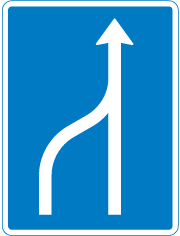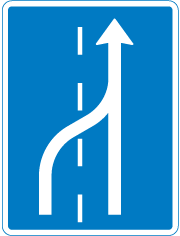



In consideration of other traffic and conditions in general, the driver must keep as far to the right as possible.
If the roadway has three lanes, a vehicle may not use the lane that is located to the far left in the direction of traffic unless the traffic on the roadway is one-way.
The distance to the vehicle ahead must be adjusted in such a way that there is no danger of collision if the vehicle in front stops or it reduces speed. Vehicles for which a special speed limit applies, see Section 43 must, outside of a dense built-up area, also keep such distance to the vehicle in front so that overtaking vehicles can drive in between such a vehicle and the vehicle in front without danger.
The driver must keep to the right of the traffic island, illuminated bollard and similar that is installed or placed on the roadway. However, the driver can drive to the left if this is indicated by marking or the layout is located on roadways with one-way traffic.
Vehicles that are used for road works can, with necessary caution, be driven as necessary in consideration of the work.
Section 42. On other roads than motorways and carriageways, the speed of the vehicle may not exceed the following limits:
Item 2. On motorways, the speed may not exceed 130 km per hour.
Item 3. On carriageways, the speed may not exceed 80 km per hour.
Item 4. For a stretch of road, a higher speed limit than the general speed limit can be set if the circumstances, including traffic flow, dictate this and critical traffic safety considerations do not speak against this. On carriageways and motorways, however, the speed may not exceed 100 km per hour and 130 km per hour, respectively.
Item 5. For a stretch of road where it would not be responsible or desirable to allow driving with speeds corresponding to the general speed limit, a lower limit can be set. In dense built-up areas, a lower speed limit for a more limited area can be set in a similar way.
Section 43. For buses, the gross weight of which exceeds 3,500 kg, the speed may not exceed 80 km per hour regardless of Section 42. For buses that fulfil the conditions set according to item 10, the speed on the motorway may not, however, exceed 100 km per hour.
Item 2. For other cars, the permitted gross weight of which exceeds 3,500 kg (lorries) and for coupled vehicles consisting of a lorry or a bus, the permitted gross weight of which exceeds 3,500 kg and a mandatory registered trailer, the speed on other roads may never exceed 70 km per hour regardless of Section 42.
Item 3. For cars with a permitted gross weight of more than 3,500 kg, the speed on other roads than motorways, regardless of Section 42, may not exceed 70 km per hour if a trailer, semi-trailer or mandatory registered towed equipment, including caravan, is attached. The same applies to motorcycles if a trailer is attached or mandatory registered towed equipment. For cars that fulfil the conditions set according to item 11, the speed on other roads than the motorway may not, however, exceed 80 km per hour.
Item 4. For the vehicles mentioned under items 2 and 3, the speed on the motorway may not exceed 80 km per hour regardless of Section 42. For cars included under item 3, that fulfil the conditions set according to item 11, the speed on the motorway may not, however, exceed 100 km per hour.
Item 5. For cars and motorcycles to which non-mandatory registered towed equipment is attached and for tractors and machinery, the speed may not exceed 30 km per hour regardless of Section 42. For approved and registered tractors and machinery as well as coupled vehicles consisting of an approved or registered tractor or approved or registered machinery is connected to approved or registered towed equipment, which fulfil the conditions set according to item 12, the speed may not exceed 40 km per hour.
Item 6. For motorized vehicles or coupled vehicles on which one or more pairs of wheels have solid wheel covering, the speed may never exceed 15 km per hour regardless of Section 42.
Item 7. With the registration or approval of a motorized vehicle, a special lower speed limit can be set if the vehicle’s construction makes this necessary.
Item 8. The Minister of Transport can, when the conditions call for it, set a higher speed limit than those mentioned under items 1-5, applicable to special types of vehicles if traffic safety or vehicle technical reasons do not speak against this.
Item 9. Regardless of the regulations under item 4, the Danish Minister of Transport can decide on the execution of trials with higher speeds on motorways for the vehicles mentioned under items 2 and 3.
Item 10. The Danish Minister of Transport can set rules on which conditions must be met so that a bus may drive up to 100 km per hour, see items 1, point 2.
Item 11. The Danish Minister of Transport can set rules on which conditions must be met so that cars with permitted gross weight of not more than 3,500 kg coupled to a trailer, semi-trailer or mandatory registered towed equipment, including caravan, may drive up to 100 km per hour on motorways and up to 80 km per hour on other roads than motorways, see item 4, point 2 and item 3, point 3.
Item 12. The Danish Minister of Transport can set rules on which conditions must be met so approved or registered tractors and machinery as well as combined vehicles consisting of an approved or registered tractor or approved or registered machinery coupled to approved or registered towed equipment may drive up to 40 km per hour, see item 5, point 2.
Section 43 a. For large mopeds, the speed may never exceed 45 km per hour regardless of Section 42. For small mopeds, the speed may never exceed 30 km per hour regardless of Section 42.
Section 43 b. The speed for light rail vehicles may not exceed the speed limit for buses, see Section 42 and Section 42, items 1 and 10.
Item 2. For a stretch of road where light rail vehicles and motorized vehicles are driven and where light rail vehicles are driven clearly separate from the other traffic, a higher speed limit than the general speed limits can be set for light rail vehicles if critical traffic considerations do not speak against this.
In those cases where the roadway has two or more lanes that are reserved for traffic in the same direction, the driver must position his vehicle in the lane far to the right in good time if he is going to turn to the right and in the lane furthest to the left if he is going to turn to the left. The driver who will drive straight on can position his vehicle in the lane which, in consideration of the other traffic and the continued driving, is the most appropriate.
Item 2. Drivers who want to change driving direction in a junction must, before preparation and execution of the manoeuvre ensure that this can be done without danger or unnecessary inconvenience to others who are driving in the same direction.
Item 3. When turning to the right, the vehicle must be driven as far out towards the roadway’s right edge as possible. The turn must be made as small as possible. When turning left, the vehicle must be driven as far as possible in towards the roadway’s centre or, if the roadway has one-way traffic, towards the roadway’s left edge. The turn must be done in such a way that when the vehicle leaves the junction, it is on the right of the roadway it is turning into.
Item 4. If the roadway into which the vehicle is turning has two or more lanes that are reserved for traffic in the same direction, regardless of the regulations in item 3, the turn must be executed in such a way that is most appropriate and in consideration of the other traffic and the continued driving.
Item 5. Oncoming traffic which, from each their side is led into a junction where they will both turn to the left, can pass each other on the left if this can be done without danger or inconvenience.
Items 1-3 also apply to driving across or away from the roadway outside of the junction.
Be ready for the theory test
You will have access to more than 1,000 multiple choice options. Our theory tests have been tested on more than 140 students before we launched it. Everyone passed the first time.
Before turning or reversing, the driver must ensure that the manoeuvre can be done without danger or inconvenience to others. Turning must be done in a forward motion to the left unless the conditions do not allow for this.
Item 2. Before moving from the edge of the road, with changing lanes or other change to the position of the vehicle, the driver must ensure that the manoeuvre can be done without danger or unnecessary inconvenience to others. The same applies when the driver wants to stop or quickly reduce speed.
Item 3. In the acceleration lane, the driver must adjust the speed to the traffic in the lane, which must be used during the continued driving and leave the acceleration lane when this can be done without danger or unnecessary inconvenience to others. Drivers in the lane which the traffic in the acceleration lane will drive into must, if necessary, ease the moving out of the acceleration lane by reducing speed.
Item 4. Where the number of lanes that are reserved for traffic in the same direction are reduced, the drivers must adjust their driving according to the changed conditions while taking mutual consideration, including possibly changing speed. The same applies to the merging of two lanes.
Item 5. The deceleration lane must be used immediately at the beginning of the lane. The same applies to lanes that are reserved for a certain type of traffic, as well as lanes that are used for turning.

When merging, you must be especially aware of:

When changing lanes, you must be especially aware of:
Take a 12-question subject test - requires Platinum access.